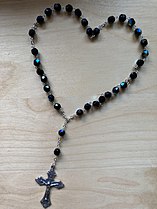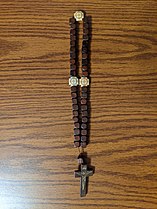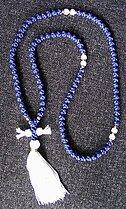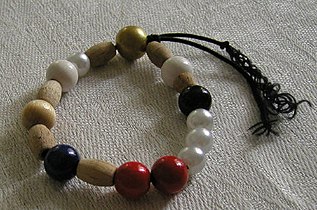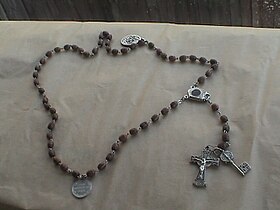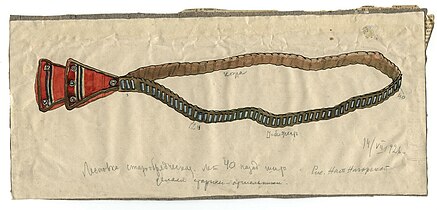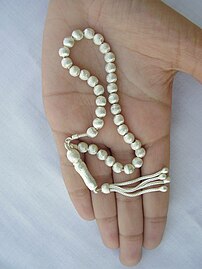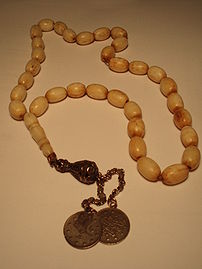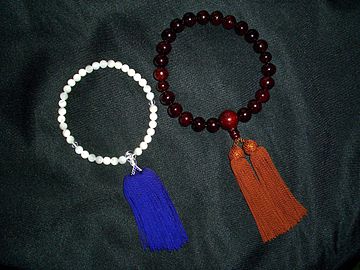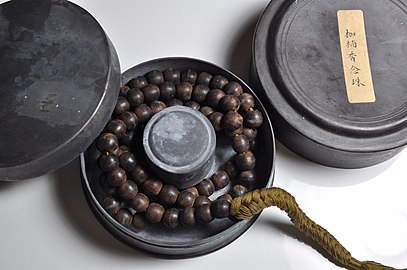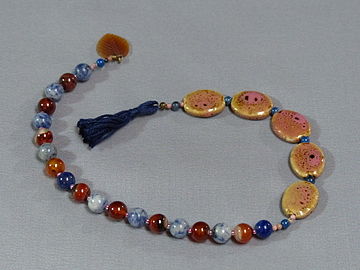Prayer beads: Difference between revisions
m Undid edits by Bikash Nepa (talk) to last revision by Caravansera: using Wikipedia for advertising/promotion |
Replacing Tespih_fcm.jpg with File:Tespih_(fcm).jpg (by CommonsDelinker because: File renamed: to harmonize the names of a set of images). |
||
| (28 intermediate revisions by 12 users not shown) | |||
| Line 4: | Line 4: | ||
{{Use dmy dates|date=July 2020}} |
{{Use dmy dates|date=July 2020}} |
||
[[File:Christian_prayer_beads.jpg|thumb|right|The image depicts several Christian prayer beads; from left to right are a Roman Catholic [[Dominican rosary]], a Lutheran [[Wreath of Christ]], a set of [[Anglican prayer beads]], a Western Christian [[Pater Noster cord]], and a Coptic Orthodox mequteria.]] |
[[File:Christian_prayer_beads.jpg|thumb|right|The image depicts several Christian prayer beads; from left to right are a Roman Catholic [[Dominican rosary]], a Lutheran [[Wreath of Christ]], a set of [[Anglican prayer beads]], a Western Christian [[Pater Noster cord]], and a Coptic Orthodox mequteria.]] |
||
'''Prayer beads''' are a form of [[beadwork]] used to count the repetitions of [[prayer]]s, [[chant]]s, or [[mantra]]s by members of various |
'''Prayer beads''' are a form of [[beadwork]] used to count the repetitions of [[prayer]]s, [[chant]]s, or [[mantra]]s by members of various [[religion]]s such as [[Hinduism]], [[Buddhism]], [[Shinto]], [[Umbanda]], [[Islam]], [[Sikhism]], the [[Baháʼí Faith]], and some [[Christian]] denominations, such as the [[Catholic Church|Roman Catholic Church]], the [[Lutheranism|Lutheran Church]], the [[Oriental Orthodox Churches]], and the [[Eastern Orthodox Church]]es. Common forms of beaded devotion include the mequteria in Oriental Orthodox Christianity, the ''[[chotki]]'' or komposkini or prayer rope in Eastern Orthodox Christianity, the [[Wreath of Christ]] in Lutheran [[Christianity]], the [[Rosary|Dominican rosary]] of the [[Mary, mother of Jesus|Blessed Virgin Mary]] in Roman Catholic Christianity, the ''[[dhikr]]'' (remembrance of God) in Islam, the ''[[japamala]]'' in Buddhism and Hinduism, and the ''[[Jaap Sahib]]'' in Sikhism. |
||
== Origins and etymology == |
== Origins and etymology == |
||
| Line 12: | Line 12: | ||
== Structure == |
== Structure == |
||
[[File:Tespih fcm.jpg|thumb|upright=0.9|A [[misbaha]], a device used for counting tasbih]] |
[[File:Tespih (fcm).jpg|thumb|upright=0.9|A [[misbaha]], a device used for counting tasbih]] |
||
The number of beads varies by religion or use. [[Islamic]] prayer beads, called [[Misbaha]] or [[Tasbih]], usually have 100 beads (99 +1 = 100 beads in total or 33 beads read thrice and +1). [[Buddhists]] and [[Hindus]] use the [[Japamala|Japa Mala]], which usually has [[Buddhist prayer beads#Numbers and symbolism|108 beads]], or 27 which are counted four times. [[Baháʼí Faith|Baháʼí]] prayer beads consist of either 95 beads or 19 beads, which are strung with the addition of five beads below. The [[Sikh]] Mala also has 108 beads. |
The number of beads varies by religion or use. [[Islamic]] prayer beads, called [[Misbaha]] or [[Tasbih]], usually have 100 beads (99 +1 = 100 beads in total or 33 beads read thrice and +1). [[Buddhists]] and [[Hindus]] use the [[Japamala|Japa Mala]], which usually has [[Buddhist prayer beads#Numbers and symbolism|108 beads]], or 27 which are counted four times. [[Baháʼí Faith|Baháʼí]] prayer beads consist of either 95 beads or 19 beads, which are strung with the addition of five beads below. The [[Sikh]] Mala also has 108 beads. |
||
The oldest set of prayer beads in [[Western Christianity]], the [[Pater Noster cord]], traditionally contains 150 beads for the 150 Psalms in the [[Bible]], though Pater Noster cords of 50 beads have been made that are prayed through thrice. [[Catholic Church|Roman Catholics]] came to use the [[Rosary]] (Latin "[[rosarium]]", meaning "rose garden") with 59 beads. The Oriental Orthodox mequteria, chiefly used by Coptic Orthodox Christians and Ethiopian Orthodox Christians, contains 41 beads for praying the [[Kyrie Eleison]] said during the 41 [[Metanoia (theology)|metanoias]] (prostrations) in each of the Christian [[fixed prayer times|seven fixed prayer times]] (cf. [[Agpeya]] breviary). [[Eastern Orthodox Church|Eastern Orthodox Christians]] use a knotted [[prayer rope]] called either a komboskini or chotki, with 100 knots, although prayer ropes with 50 or 33 knots can also be used. The Lutheran [[Wreath of Christ]] contains 18 beads. In the 1980s Rev. Lynn Bauman from the [[Episcopal Church (United States)|Protestant Episcopal Church in the United States of America]] introduced [[Anglican prayer beads]] with 33 beads.<ref name="kingofpeace">{{Cite web |url=http://kingofpeace.org/prayerbeads.htm |title=Anglican Prayer Beads |access-date=24 December 2010 |archive-date=19 December 2010 |archive-url=https://web.archive.org/web/20101219210122/http://kingofpeace.org/prayerbeads.htm |url-status=live }}</ref> |
The oldest set of prayer beads in [[Western Christianity]], the [[Pater Noster cord]], traditionally contains 150 beads for the 150 Psalms in the [[Bible]], though Pater Noster cords of 50 beads have been made that are prayed through thrice. [[Catholic Church|Roman Catholics]] came to use the [[Rosary]] (Latin "[[rosarium]]", meaning "rose garden") with 59 beads. The Oriental Orthodox mequteria, chiefly used by Coptic Orthodox Christians and Ethiopian Orthodox Christians, contains 41 beads for praying the [[Kyrie Eleison]] said during the 41 [[Metanoia (theology)|metanoias]] (prostrations) in each of the Christian [[fixed prayer times|seven fixed prayer times]] (cf. [[Agpeya]] breviary). [[Eastern Orthodox Church|Eastern Orthodox Christians]] and [[Eastern Catholic Church|Eastern Catholic Christians]] use a knotted [[prayer rope]] called either a komboskini or chotki, with 100 knots, although prayer ropes with 50 or 33 knots can also be used. The Lutheran [[Wreath of Christ]] contains 18 beads. In the 1980s Rev. Lynn Bauman from the [[Episcopal Church (United States)|Protestant Episcopal Church in the United States of America]] introduced [[Anglican prayer beads]] with 33 beads.<ref name="kingofpeace">{{Cite web |url=http://kingofpeace.org/prayerbeads.htm |title=Anglican Prayer Beads |access-date=24 December 2010 |archive-date=19 December 2010 |archive-url=https://web.archive.org/web/20101219210122/http://kingofpeace.org/prayerbeads.htm |url-status=live }}</ref> |
||
The Greek "[[komboloi]]" (which are [[worry beads]] and have no religious purpose) has an odd number of beads—usually one more than a multiple of four, e.g. (4x4)+1, (5x4)+1. |
The Greek "[[komboloi]]" (which are [[worry beads]] and have no religious purpose) has an odd number of beads—usually one more than a multiple of four, e.g. (4x4)+1, (5x4)+1. |
||
| Line 23: | Line 23: | ||
=== Judaism === |
=== Judaism === |
||
Although the use of prayer beads grew within |
Although the use of prayer beads grew within other religions, it did not enter [[Judaism]], perhaps because of its association with those religions, and to date Judaism does not normally use prayer beads. Although not used as counting device, many Jews touch the knots on the [[tzitzit]]s attached to their [[tallit]] (prayer shawl) at specific points in their prayers.<ref name=Win4 /> However, some individual Jews use prayer beads, either out of familiarity (such as in the case of converts),<ref name=":2">{{Cite web |title=Judaism, Lessons, Times {{!}} Yeshiva.co |url=https://www.yeshiva.co/ask/58710 |access-date=2024-06-07 |website=Yeshiva Site |language=en}}</ref> or because they simply like to.<ref>{{Cite web |title=Beads |url=https://velveteenrabbi.blogs.com/blog/2014/11/beads.html |website=The Velveteen Rabbi}}</ref> So long as the beads have and will not be used in prayers for a contradictory religion, such as Christianity, and do not bear symbols of such a religion, they are understood as acceptable to use.<ref name=":2" /> These may be an existing strand of plain beads, such as mala beads, but one design specific to Judaism has 19 beads: 6 and 13, divided by a separator, to symbolize the 613 mitzvot.<ref>{{Cite web |title=Judaism, Lessons, Times {{!}} Yeshiva.co |url=https://www.yeshiva.co/ask/61069 |access-date=2024-10-30 |website=Yeshiva Site |language=en}}</ref> |
||
=== Christianity === |
=== Christianity === |
||
{{Main|Rosary|Prayer rope|Chaplet (prayer)|Wreath of Christ|Anglican prayer beads}} |
{{Main|Rosary|Prayer rope|Chaplet (prayer)|Wreath of Christ|Anglican prayer beads}} |
||
The [[Desert Fathers]] of the 3rd to 5th centuries, used pebbles or knotted ropes to count prayers, typically the [[Jesus Prayer]] ("Lord Jesus Christ, Son of God, have mercy on me, a sinner"). The invention is attributed to [[Anthony the Great]] or his associate [[Pachomius the Great]] in the 4th century. In Vita of Saint Paul of Thebes (227 AD to 342 AD), written by Saint Jerome (347 AD to 420 AD) it states that Saint Paul of Thebes used pebbles and knotted cord to count prayers.<ref>{{cite book |last1=Curta |first1=Florin |title=Great Events in Religion |date=28 November 2016 |isbn=9781610695664 |url=https://books.google.com/books?id=dgF9DQAAQBAJ&q=st+paul+of+thebes+and+prayer+beads&pg=PA393 |access-date=19 October 2020 |archive-date=27 March 2023 |archive-url=https://web.archive.org/web/20230327184134/https://books.google.com/books?id=dgF9DQAAQBAJ&q=st+paul+of+thebes+and+prayer+beads&pg=PA393 |url-status=live }}</ref> |
The [[Desert Fathers]] of the 3rd to 5th centuries, used pebbles or knotted ropes to count prayers, typically the [[Jesus Prayer]] ("Lord Jesus Christ, Son of God, have mercy on me, a sinner"). The invention is attributed to [[Anthony the Great]] or his associate [[Pachomius the Great]] in the 4th century. In Vita of Saint Paul of Thebes (227 AD to 342 AD), written by Saint Jerome (347 AD to 420 AD) it states that Saint Paul of Thebes used pebbles and knotted cord to count prayers.<ref>{{cite book |last1=Curta |first1=Florin |title=Great Events in Religion |date=28 November 2016 |publisher=Abc-Clio |isbn=9781610695664 |url=https://books.google.com/books?id=dgF9DQAAQBAJ&q=st+paul+of+thebes+and+prayer+beads&pg=PA393 |access-date=19 October 2020 |archive-date=27 March 2023 |archive-url=https://web.archive.org/web/20230327184134/https://books.google.com/books?id=dgF9DQAAQBAJ&q=st+paul+of+thebes+and+prayer+beads&pg=PA393 |url-status=live }}</ref> |
||
Around the 8th century, [[Paternoster cords]] were used to count the 150 [[Psalms]] of the Bible, but for those who could not read, they were used to count 150 recitations of the [[Lord's Prayer]].<ref name="KarrasKayeMatter2013">{{cite book |last1=Karras |first1=Ruth Mazo |last2=Kaye |first2=Joel |last3=Matter |first3=E. Ann |title=Law and the Illicit in Medieval Europe |date=11 February 2013 |publisher=[[University of Pennsylvania Press]] |isbn=978-0-8122-0885-6 |page=223 |language=English}}</ref><ref>{{cite web |title=Pater Noster Cords |url=http://www.solitariesofdekoven.org/how_to_use.html#cords |publisher=Solitaries of DeKoven |access-date=10 March 2022 |language=English |quote=Monks and clergy recited or chanted the Psalms as a major source of hourly worship. People living near the monasteries/abbeys realized the beauty of this devotion but unable to read or memorize the lengthy Psalms, the people were unable to adapt this form of prayer for their use. It was suggested that the people might substitute 150 Our Fathers in place of the Psalms. |archive-date=29 March 2022 |archive-url=https://web.archive.org/web/20220329233642/http://www.solitariesofdekoven.org/how_to_use.html#cords |url-status=live }}</ref><ref name = Thurston-Shipman>{{cite book | last1 = Thurston | first1 = Herbert | author-link1 = Herbert Thurston | last2 = Shipman | first2 = Andrew | year = 1912 | chapter = The Rosary | title = The Catholic Encyclopedia. Vol. 13 | place = New York | publisher = Robert Appleton Company | url = http://www.newadvent.org/cathen/13184b.htm | access-date = 11 July 2014 | archive-date = 3 July 2014 | archive-url = https://web.archive.org/web/20140703043313/http://www.newadvent.org/cathen/13184b.htm | url-status = live }}</ref> The ''Catholic Encyclopedia'' thus mentions strings of beads, presumably for prayer, found in the tombs of [[Saint Gertrude of Nivelles]] (7th century) and [[Norbert of Xanten|Saint Norbert]] and [[Saint Rosalia]] (12th century).<ref name=Volz>{{cite book | last = Volz | first = John | year = 1907 | chapter = Use of Beads at Prayers | title = The Catholic Encyclopedia. Vol. 2 | place = New York | publisher = Robert Appleton Company | url = http://www.newadvent.org/cathen/02361c.htm | access-date = 11 July 2014 | archive-date = 1 July 2014 | archive-url = https://web.archive.org/web/20140701040651/http://newadvent.org/cathen/02361c.htm | url-status = live }}</ref> A more explicit reference is that in 1125 [[William of Malmesbury]] mentioned a string of gems that [[Lady Godiva]] used to count prayers.<ref name=Volz/><ref>{{cite book | author = William of Malmesbury | author-link = William of Malmesbury | orig-year = 1125 | year = 2012 | title = Willelmi Malmesbiriensis Monachi De Gestis Pontificum Anglorum Libri Quinque | edition = Reprint of 1870 | editor = Hamilton, N. E. S. A. | publisher = Cambridge University Press | series = Cambridge Library Collection – Rolls| page = 311 | isbn = 978-1-108-04886-6 | url = https://books.google.com/books?id=_NqOe4Z-zTcC&pg=PA311 | access-date = 11 July 2014 | language = la}}</ref> The oldest prayer beads to be found in Britain were discovered by archaeologists on [[Lindisfarne]] in 2022: made of salmon vertebrae, they date from the 8th or 9th century.<ref>{{cite news| title=First ever prayer beads from medieval Britain discovered| author=Dalya Alberge| date=26 June 2022| newspaper=The Telegraph| url=https://www.telegraph.co.uk/news/2022/06/26/first-ever-example-prayer-beads-medieval-britain-discovered/| language=en| access-date=26 June 2022| archive-date=26 June 2022| archive-url=https://web.archive.org/web/20220626181644/https://www.telegraph.co.uk/news/2022/06/26/first-ever-example-prayer-beads-medieval-britain-discovered/| url-status=live}}</ref> |
Around the 8th century, [[Paternoster cords]] were used to count the 150 [[Psalms]] of the Bible, but for those who could not read, they were used to count 150 recitations of the [[Lord's Prayer]].<ref name="KarrasKayeMatter2013">{{cite book |last1=Karras |first1=Ruth Mazo |last2=Kaye |first2=Joel |last3=Matter |first3=E. Ann |title=Law and the Illicit in Medieval Europe |date=11 February 2013 |publisher=[[University of Pennsylvania Press]] |isbn=978-0-8122-0885-6 |page=223 |language=English}}</ref><ref>{{cite web |title=Pater Noster Cords |url=http://www.solitariesofdekoven.org/how_to_use.html#cords |publisher=Solitaries of DeKoven |access-date=10 March 2022 |language=English |quote=Monks and clergy recited or chanted the Psalms as a major source of hourly worship. People living near the monasteries/abbeys realized the beauty of this devotion but unable to read or memorize the lengthy Psalms, the people were unable to adapt this form of prayer for their use. It was suggested that the people might substitute 150 Our Fathers in place of the Psalms. |archive-date=29 March 2022 |archive-url=https://web.archive.org/web/20220329233642/http://www.solitariesofdekoven.org/how_to_use.html#cords |url-status=live }}</ref><ref name = Thurston-Shipman>{{cite book | last1 = Thurston | first1 = Herbert | author-link1 = Herbert Thurston | last2 = Shipman | first2 = Andrew | year = 1912 | chapter = The Rosary | title = The Catholic Encyclopedia. Vol. 13 | place = New York | publisher = Robert Appleton Company | url = http://www.newadvent.org/cathen/13184b.htm | access-date = 11 July 2014 | archive-date = 3 July 2014 | archive-url = https://web.archive.org/web/20140703043313/http://www.newadvent.org/cathen/13184b.htm | url-status = live }}</ref> The ''Catholic Encyclopedia'' thus mentions strings of beads, presumably for prayer, found in the tombs of [[Saint Gertrude of Nivelles]] (7th century) and [[Norbert of Xanten|Saint Norbert]] and [[Saint Rosalia]] (12th century).<ref name=Volz>{{cite book | last = Volz | first = John | year = 1907 | chapter = Use of Beads at Prayers | title = The Catholic Encyclopedia. Vol. 2 | place = New York | publisher = Robert Appleton Company | url = http://www.newadvent.org/cathen/02361c.htm | access-date = 11 July 2014 | archive-date = 1 July 2014 | archive-url = https://web.archive.org/web/20140701040651/http://newadvent.org/cathen/02361c.htm | url-status = live }}</ref> A more explicit reference is that in 1125 [[William of Malmesbury]] mentioned a string of gems that [[Lady Godiva]] used to count prayers.<ref name=Volz/><ref>{{cite book | author = William of Malmesbury | author-link = William of Malmesbury | orig-year = 1125 | year = 2012 | title = Willelmi Malmesbiriensis Monachi De Gestis Pontificum Anglorum Libri Quinque | edition = Reprint of 1870 | editor = Hamilton, N. E. S. A. | publisher = Cambridge University Press | series = Cambridge Library Collection – Rolls| page = 311 | isbn = 978-1-108-04886-6 | url = https://books.google.com/books?id=_NqOe4Z-zTcC&pg=PA311 | access-date = 11 July 2014 | language = la}}</ref> The oldest prayer beads to be found in Britain were discovered by archaeologists on [[Lindisfarne]] in 2022: made of salmon vertebrae, they date from the 8th or 9th century.<ref>{{cite news| title=First ever prayer beads from medieval Britain discovered| author=Dalya Alberge| date=26 June 2022| newspaper=The Telegraph| url=https://www.telegraph.co.uk/news/2022/06/26/first-ever-example-prayer-beads-medieval-britain-discovered/| language=en| access-date=26 June 2022| archive-date=26 June 2022| archive-url=https://web.archive.org/web/20220626181644/https://www.telegraph.co.uk/news/2022/06/26/first-ever-example-prayer-beads-medieval-britain-discovered/| url-status=live}}</ref> |
||
| Line 35: | Line 35: | ||
In [[Oriental Orthodox Christianity]], especially among Ethiopian Christians and Coptic Christians, prayer beads known as the mequetaria/mequteria employ numbers such as 41, 64, and 100 as their length; the mequetaria is chiefly used for reciting the Kyrie Eleison (Lord have mercy) during the [[fixed prayer times|seven fixed prayer times]] of Christianity. In regards to the first two numbers, the former represent the number of wounds inflicted on Jesus from lashing, the nails, and the lance while the latter represents Mary's age upon her Assumption. |
In [[Oriental Orthodox Christianity]], especially among Ethiopian Christians and Coptic Christians, prayer beads known as the mequetaria/mequteria employ numbers such as 41, 64, and 100 as their length; the mequetaria is chiefly used for reciting the Kyrie Eleison (Lord have mercy) during the [[fixed prayer times|seven fixed prayer times]] of Christianity. In regards to the first two numbers, the former represent the number of wounds inflicted on Jesus from lashing, the nails, and the lance while the latter represents Mary's age upon her Assumption. |
||
The [[Eastern Orthodox Church]] uses [[prayer rope]]s that usually come with 33, 50 or 100 knots. The [[prayer rope|loops of knotted wool]] (or occasionally of beads), called ''chotki'' or ''komboskini'' to pray the [[Jesus Prayer]]. Among Russian [[Old Believers]], a prayer rope made of leather, called '[[lestovka]]', is more common, although this type is no longer commonly used now by the [[Russian Orthodox Church]]. According to the ''[[Catholic Encyclopedia]]'', "The [[rosary]] is conferred upon the [[Greek Orthodox Church|Greek Orthodox]] monk as a part of his investiture with the [[Mantle (vesture)|mandyas]] or full [[religious habit|monastic habit]], as the second step in [[Christian monasticism|monastic life]], and is called his 'spiritual sword'."<ref name = Thurston-Shipman/> |
The [[Eastern Orthodox Church]] uses [[prayer rope]]s that usually come with 33, 50 or 100 knots. The [[prayer rope|loops of knotted wool]] (or occasionally of beads), called ''brojanica (Serbian, Macedonian),'' ''chotki (Russian)'' or ''komboskini (Greek)'' to pray the [[Jesus Prayer]]. Among Russian [[Old Believers]], a prayer rope made of leather, called '[[lestovka]]', is more common, although this type is no longer commonly used now by the [[Russian Orthodox Church]]. According to the ''[[Catholic Encyclopedia]]'', "The [[rosary]] is conferred upon the [[Greek Orthodox Church|Greek Orthodox]] monk as a part of his investiture with the [[Mantle (vesture)|mandyas]] or full [[religious habit|monastic habit]], as the second step in [[Christian monasticism|monastic life]], and is called his 'spiritual sword'."<ref name = Thurston-Shipman/> |
||
The Lutheran [[Wreath of Christ]],<ref>[http://www.verbumkampanj.se/verbum/1238178-pearlsoflife Pearls of Life] {{webarchive|url=https://web.archive.org/web/20100821161047/http://www.verbumkampanj.se/verbum/1238178-pearlsoflife |date=21 August 2010 }} Retrieved on 9 March 2010</ref> invented by [[Martin Lönnebo]], Bishop [[Emeritus]] of the [[Diocese of Linköping]] of the [[Church of Sweden|Swedish Lutheran Church]], is a set of 18 beads, some round and some elongated, arranged in an irregular pattern. Each one has its own significance as a stimulus and reminder for meditation, although they can also be used for repetitive prayer.<ref name=fralsarkransen>{{cite news |url=http://www.dn.se/kultur-noje/kulturdebatt/sa-blev-fralsarkransen-sveriges-forsta-moderna-radband/ |title=Så blev Frälsarkransen Sveriges första moderna radband |last=Lerner |first=Thomas |language=sv |newspaper=[[Dagens Nyheter]] |date=2 February 2015 |access-date=12 August 2016 |archive-date=27 March 2023 |archive-url=https://web.archive.org/web/20230327184252/https://www.dn.se/kultur-noje/kulturdebatt/sa-blev-fralsarkransen-sveriges-forsta-moderna-radband/ |url-status=live }}</ref> |
The Lutheran [[Wreath of Christ]],<ref>[http://www.verbumkampanj.se/verbum/1238178-pearlsoflife Pearls of Life] {{webarchive|url=https://web.archive.org/web/20100821161047/http://www.verbumkampanj.se/verbum/1238178-pearlsoflife |date=21 August 2010 }} Retrieved on 9 March 2010</ref> invented by [[Martin Lönnebo]], Bishop [[Emeritus]] of the [[Diocese of Linköping]] of the [[Church of Sweden|Swedish Lutheran Church]], is a set of 18 beads, some round and some elongated, arranged in an irregular pattern. Each one has its own significance as a stimulus and reminder for meditation, although they can also be used for repetitive prayer.<ref name=fralsarkransen>{{cite news |url=http://www.dn.se/kultur-noje/kulturdebatt/sa-blev-fralsarkransen-sveriges-forsta-moderna-radband/ |title=Så blev Frälsarkransen Sveriges första moderna radband |last=Lerner |first=Thomas |language=sv |newspaper=[[Dagens Nyheter]] |date=2 February 2015 |access-date=12 August 2016 |archive-date=27 March 2023 |archive-url=https://web.archive.org/web/20230327184252/https://www.dn.se/kultur-noje/kulturdebatt/sa-blev-fralsarkransen-sveriges-forsta-moderna-radband/ |url-status=live }}</ref> |
||
In the mid-1980s, [[Anglican prayer beads]] were developed in the [[Episcopal Church (United States)|Protestant Episcopal Church in the United States]], originating in the [[Episcopal Diocese of Texas|Diocese of Texas]].<ref name="kingofpeace"/> The set consists of 33 beads (representing the 33 years of the life of [[Christ]]) arranged in four groupings of symbolic significance. |
In the mid-1980s, [[Anglican prayer beads]] were developed in the [[Episcopal Church (United States)|Protestant Episcopal Church in the United States]], originating in the [[Episcopal Diocese of Texas|Diocese of Texas]].<ref name="kingofpeace"/> The set consists of 33 beads (representing the 33 years of the life of [[Christ]]) arranged in four groupings of symbolic significance. |
||
While there are liturgical churches using prayer beads in prayer, non-liturgical Christian churches do not use them. |
While there are liturgical churches using prayer beads in prayer, non-liturgical Christian churches do not use them. |
||
| Line 58: | Line 58: | ||
=== Islam === |
=== Islam === |
||
{{main|Misbaha|Tasbih}} |
{{main|Misbaha|Tasbih}} |
||
In [[Islam]], prayer beads are referred to as [[misbaha]] ({{ |
In [[Islam]], prayer beads are referred to as [[misbaha]] ({{langx|ar|مِسْبَحَة|misbaḥah}}), subha, or as [[tasbih]] in reference to the prayers they are used with. They typically possess 99 regularly sized beads (corresponding to the [[names of God in Islam]]) with separators of two smaller beads, splitting the loop into three sections of 33 each. Sometimes, a misbaha of only 33 beads is used, in which case one would cycle through its beads three times. The tasbih prayer is a [[dhikr]] that involves the repetitive utterances of short sentences to praise and glorify God. |
||
Most currents of mainstream Islam consider the use of the misbaha in prayer and recitations to be an accepted practice.<ref>{{Cite web|url=http://seekershub.org/ans-blog/2009/09/10/is-using-a-prayer-bead-an-innovation/|title=Is Using Prayer Beads An Innovation? - SeekersHub Answers|date=2009-09-11|language=en-US|access-date=2016-09-28|archive-date=2 October 2016|archive-url=https://web.archive.org/web/20161002024304/http://seekershub.org/ans-blog/2009/09/10/is-using-a-prayer-bead-an-innovation/|url-status=dead}}</ref> According to [[Mirza Tahir Ahmad]], the former head of the [[Ahmadiyya]] Islamic revival community, the use of prayer beads is considered an [[bid‘ah|innovation]] not practiced by early Muslims.<ref>{{cite web | url=http://www.askislam.org/practices/question_817.html | title=Why do Ahmadi Muslims not use Tasbeeh (prayer beads)? | publisher=askislam.org | access-date=7 April 2014 | archive-date=18 August 2014 | archive-url=https://web.archive.org/web/20140818135058/http://www.askislam.org/practices/question_817.html | url-status=live }}</ref> |
Most currents of mainstream Islam consider the use of the misbaha in prayer and recitations to be an accepted practice.<ref>{{Cite web|url=http://seekershub.org/ans-blog/2009/09/10/is-using-a-prayer-bead-an-innovation/|title=Is Using Prayer Beads An Innovation? - SeekersHub Answers|date=2009-09-11|language=en-US|access-date=2016-09-28|archive-date=2 October 2016|archive-url=https://web.archive.org/web/20161002024304/http://seekershub.org/ans-blog/2009/09/10/is-using-a-prayer-bead-an-innovation/|url-status=dead}}</ref> According to [[Mirza Tahir Ahmad]], the former head of the [[Ahmadiyya]] Islamic revival community, the use of prayer beads is considered an [[bid‘ah|innovation]] not practiced by early Muslims.<ref>{{cite web | url=http://www.askislam.org/practices/question_817.html | title=Why do Ahmadi Muslims not use Tasbeeh (prayer beads)? | publisher=askislam.org | access-date=7 April 2014 | archive-date=18 August 2014 | archive-url=https://web.archive.org/web/20140818135058/http://www.askislam.org/practices/question_817.html | url-status=live }}</ref> |
||
| Line 72: | Line 72: | ||
{{further|Mool Mantar}} |
{{further|Mool Mantar}} |
||
[[Sikh]] worshipers may use ''mala'' (prayer beads) while reciting verses from the Guru Granth Sahib.<ref>{{cite web|url=http://sikhism.about.com/od/Sikhism_Glossary_M/g/Mala-Rosary-Prayer-Beads.htm|title=How Are Mala Rosary Prayer Beads Used in Sikhism?|website=about.com|access-date=21 January 2018|archive-date=5 March 2016|archive-url=https://web.archive.org/web/20160305001436/http://sikhism.about.com/od/Sikhism_Glossary_M/g/Mala-Rosary-Prayer-Beads.htm|url-status=dead}}</ref> These prayer beads |
[[Sikh]] worshipers may use ''mala'' (prayer beads) while reciting verses from the Guru Granth Sahib.<ref>{{cite web|url=http://sikhism.about.com/od/Sikhism_Glossary_M/g/Mala-Rosary-Prayer-Beads.htm|title=How Are Mala Rosary Prayer Beads Used in Sikhism?|website=about.com|access-date=21 January 2018|archive-date=5 March 2016|archive-url=https://web.archive.org/web/20160305001436/http://sikhism.about.com/od/Sikhism_Glossary_M/g/Mala-Rosary-Prayer-Beads.htm|url-status=dead}}</ref> These prayer beads are made from iron worn around the wrist; there are 27 such beads in a ''mala''.<ref name=":1" /> This is also known as a ''simranee''. |
||
=== Hinduism === |
=== Hinduism === |
||
{{Main|Japamala}} |
{{Main|Japamala}} |
||
An early use of prayer beads can be traced to [[Hinduism]]<ref>{{cite web |url=http://dharma-beads.net/rosaries-india |title=''Rosaries of India'' |access-date=2012-01-14 |last=Untracht |first=Oppi |year=2008 |work=Traditional Jewelry of India |archive-date=23 January 2012 |archive-url=https://web.archive.org/web/20120123101501/http://dharma-beads.net/rosaries-india |url-status=live }}</ref><ref>{{cite web|url=http://dharma-beads.net/books/beads-faith/hindu-malas|title=Hindu Malas|website=dharma-beads.net|access-date=21 January 2018|archive-date=21 January 2018|archive-url=https://web.archive.org/web/20180121125828/http://dharma-beads.net/books/beads-faith/hindu-malas|url-status=live}}</ref><ref>{{cite web|url=http://dharma-beads.net/history-prayer-beads|title=Prayer Beads|website=dharma-beads.net|access-date=21 January 2018|archive-date=28 January 2012|archive-url=https://web.archive.org/web/20120128150355/http://dharma-beads.net/history-prayer-beads|url-status=dead}}</ref> where they are called ''[[japamala]]''. [[Japa]] is the repeating of the name of a deity or a [[mantra]]. ''Mala'' ({{ |
An early use of prayer beads can be traced to [[Hinduism]]<ref>{{cite web |url=http://dharma-beads.net/rosaries-india |title=''Rosaries of India'' |access-date=2012-01-14 |last=Untracht |first=Oppi |year=2008 |work=Traditional Jewelry of India |archive-date=23 January 2012 |archive-url=https://web.archive.org/web/20120123101501/http://dharma-beads.net/rosaries-india |url-status=live }}</ref><ref>{{cite web|url=http://dharma-beads.net/books/beads-faith/hindu-malas|title=Hindu Malas|website=dharma-beads.net|access-date=21 January 2018|archive-date=21 January 2018|archive-url=https://web.archive.org/web/20180121125828/http://dharma-beads.net/books/beads-faith/hindu-malas|url-status=live}}</ref><ref>{{cite web|url=http://dharma-beads.net/history-prayer-beads|title=Prayer Beads|website=dharma-beads.net|access-date=21 January 2018|archive-date=28 January 2012|archive-url=https://web.archive.org/web/20120128150355/http://dharma-beads.net/history-prayer-beads|url-status=dead}}</ref> where they are called ''[[japamala]]''. [[Japa]] is the repeating of the name of a deity or a [[mantra]]. ''Mala'' ({{langx|sa|माला}} {{IAST|mālā}}) means "garland" or "wreath".<ref name="apte">{{cite book | last = Apte | first = Vaman Shivaram | title = A Practical Sanskrit Dictionary | pages = 1267 | url = https://dsal.uchicago.edu/cgi-bin/philologic/getobject.pl?c.4:1:3876.apte | archive-url = https://archive.today/20121215094421/http://dsal.uchicago.edu/cgi-bin/philologic/getobject.pl?c.4:1:3876.apte | url-status = dead | archive-date = 15 December 2012 }}</ref> |
||
Japamala are used for repetition of a |
Japamala are used for repetition of a mantra, for other forms of [[sādhanā]] or "spiritual exercise" and as an aid to [[meditation]]. The most common ''mala'' have 108 beads.<ref name="salagram">{{Cite book | title = The Significance of the number 108. | url = http://www.salagram.net/108meaning.html | access-date = 2007-12-23 | archive-date = 13 August 2010 | archive-url = https://web.archive.org/web/20100813112630/http://www.salagram.net/108meaning.html | url-status = live }}</ref> The most common materials used for making the beads are [[Rudraksha|Rudraksha seeds]] (used by [[Shaivism|Shaivites]]) and [[Ocimum tenuiflorum]] (''tulasi'') stems (used by [[Vaishnavism|Vaishnavites]]).<ref name=":1">{{Cite journal |last=Blackman |first=Winifred S. |date=1918 |title=The Rosary in Magic and Religion |url=https://www.jstor.org/stable/1255280 |journal=Folklore |volume=29 |issue=4 |pages=255–280 |doi=10.1080/0015587X.1918.9719067 |jstor=1255280 |via=JSTOR}}</ref> Shaivites believe that the Rudraksha Japa Mala<ref>{{Cite web |title=Rudraksha Japa Mala |url=https://nepalirudraksha.com/collections/rudraksha-japa-mala |website=Nepa Rudraksha}}</ref> epitomizes ancient wisdom and mystical energies, offering seekers a conduit to inner peace and spiritual harmony.<ref>{{Cite web |last=Kunwar |first=Amit |title=Japa Mala |url=https://www.rudrakshanepal.org/japa-mala/ }}</ref> Other materials such as metals, seeds of a lotus and pearls are also used to make the beads.<ref name=":0">{{Cite journal |last=Kulkarni |first=Pradnya |date=2010–2011 |title=Application of Hindu Rosary as a Magical Device |url=https://www.jstor.org/stable/42931265 |journal=Bulletin of the Deccan College Post-Graduate and Research Institute |volume=70/71 |pages=419–428 |jstor=42931265 |via=JSTOR}}</ref> |
||
While using the prayer beads, one bead is moved at a time until arriving to the terminal bead. Once the terminal bead is touched, the prayer beads are reversed and counted in the opposite direction. It is held in a particular manner using the middle finger and thumb only, deliberately avoiding the use of the index finger - considering it to be inauspiciousness. The user also covers the prayer beads with a cloth called bag called "''gomukha."''<ref name=":0" /> {{gallery |
|||
According to Vedic scriptures 103 beads were used during [[Treta Yuga]], 108 beads during [[Dvapara Yuga]], and 111 beads in [[Kali Yuga]].{{citation needed|date=February 2018}} |
|||
According to Hindu Sashtras there must be 108 beads.<ref name="Rudraksha Five Mukhi">{{cite web | title = Importance of 108 beads. | url = https://www.rudrakshanepal.com/meditation-and-religious-rosaries | access-date = 26 August 2020 | archive-date = 10 August 2020 | archive-url = https://web.archive.org/web/20200810212606/http://www.rudrakshanepal.com/meditation-and-religious-rosaries/ | url-status = dead }}</ref> Generally for meditation rudraksha beads, lotus seeds are used. |
|||
{{gallery |
|||
| align = center |
| align = center |
||
| mode = packed |
| mode = packed |
||
| Line 93: | Line 89: | ||
=== Buddhism === |
=== Buddhism === |
||
{{Main|Japamala}} |
{{Main|Japamala}} |
||
Prayer beads ({{zh|c=佛珠; 念珠|p=fózhū, niànzhū}}, {{ |
Prayer beads ({{zh|c=佛珠; 念珠|p=fózhū, niànzhū}}, {{langx|ja|数珠|juzu, zuzu}}, {{korean|염주}} (yeomju), {{langx|bo|ཕྲེང་བ།|translit=phreng ba}}) are also used in many forms of [[Mahayana]] [[Buddhism]], often with a lesser number of beads (usually a divisor of 108). In [[Pure Land Buddhism]], for instance, 27-bead ''mala''s are common. These shorter malas are sometimes called "prostration rosaries" because they are easier to hold when enumerating repeated [[prostration]]s. In [[Tibetan Buddhism]] malas are also 108 beads: one mala counts as 100 [[mantra]]s, and the eight extra are meant to be dedicated to all [[sentience|sentient]] beings (the practice as a whole is dedicated at its end as well). In [[Tibetan Buddhism]], often larger malas are used; for example, malas of 111 beads. When counting, they calculate one mala as 100 mantras and the 11 additional beads are taken as extra to compensate for errors.{{Verify source|date=May 2014}} |
||
Various type of materials are used to make mala beads such as seeds of the [[rudraksha]], beads made from the wood of the tulsi plant, animal bone, wood or seeds from the [[Bodhi Tree]] (a particularly sacred tree of the species [[Ficus religiosa]]) or of [[Nelumbo nucifera]] (the lotus plant). Semi-precious stones like [[carnelian]] and [[amethyst]] are also used. Another commonly used material is [[sandalwood]].<ref>[http://www.prayerbeadsworld.com/prayer_beads_in_buddhism.html Prayer beads in Buddhism] {{Webarchive|url=https://web.archive.org/web/20150516045022/http://www.prayerbeadsworld.com/prayer_beads_in_buddhism.html |date=16 May 2015 }} Retrieved 18 December 2008</ref> |
Various type of materials are used to make mala beads such as seeds of the [[rudraksha]], beads made from the wood of the tulsi plant, animal bone, wood or seeds from the [[Bodhi Tree]] (a particularly sacred tree of the species [[Ficus religiosa]]) or of [[Nelumbo nucifera]] (the lotus plant). Semi-precious stones like [[carnelian]] and [[amethyst]] are also used. Another commonly used material is [[sandalwood]].<ref>[http://www.prayerbeadsworld.com/prayer_beads_in_buddhism.html Prayer beads in Buddhism] {{Webarchive|url=https://web.archive.org/web/20150516045022/http://www.prayerbeadsworld.com/prayer_beads_in_buddhism.html |date=16 May 2015 }} Retrieved 18 December 2008</ref> |
||
Latest revision as of 13:29, 3 November 2024
This article needs additional citations for verification. (May 2008) |

Prayer beads are a form of beadwork used to count the repetitions of prayers, chants, or mantras by members of various religions such as Hinduism, Buddhism, Shinto, Umbanda, Islam, Sikhism, the Baháʼí Faith, and some Christian denominations, such as the Roman Catholic Church, the Lutheran Church, the Oriental Orthodox Churches, and the Eastern Orthodox Churches. Common forms of beaded devotion include the mequteria in Oriental Orthodox Christianity, the chotki or komposkini or prayer rope in Eastern Orthodox Christianity, the Wreath of Christ in Lutheran Christianity, the Dominican rosary of the Blessed Virgin Mary in Roman Catholic Christianity, the dhikr (remembrance of God) in Islam, the japamala in Buddhism and Hinduism, and the Jaap Sahib in Sikhism.
Origins and etymology
[edit]Beads are among the earliest human ornaments and ostrich eggshell beads in Africa date to 10,000 BC.[1] Over the centuries various cultures have made beads from a variety of material from stone and shells to clay.[1]
The English word bead derives from the Old English noun bede which means a prayer.[2][3][4][5] The oldest image of a string of beads in a religious context and resembling a string of prayer beads is found on the fresco of the "Adorants" (or "Worshipers") at the Xeste 3 building of the prehistoric settlement of Akrotiri, Santorini (Thera,) Greece (Wall Paintings of Thera.)[6] dating from the 17th century BC (c. 1613 BC.) It was used in Hindu Prayers and meditation Hindu prayers in India.[citation needed] Buddhism later on adopted this custom.[citation needed] As the Ancient Hindus migrated towards West Asia this practice was carried to many parts of the world and became a part of different religions.[1][3][7] The statue of a Hindu holy man with beads dates to the third century BC.[3][7]
Structure
[edit]
The number of beads varies by religion or use. Islamic prayer beads, called Misbaha or Tasbih, usually have 100 beads (99 +1 = 100 beads in total or 33 beads read thrice and +1). Buddhists and Hindus use the Japa Mala, which usually has 108 beads, or 27 which are counted four times. Baháʼí prayer beads consist of either 95 beads or 19 beads, which are strung with the addition of five beads below. The Sikh Mala also has 108 beads.
The oldest set of prayer beads in Western Christianity, the Pater Noster cord, traditionally contains 150 beads for the 150 Psalms in the Bible, though Pater Noster cords of 50 beads have been made that are prayed through thrice. Roman Catholics came to use the Rosary (Latin "rosarium", meaning "rose garden") with 59 beads. The Oriental Orthodox mequteria, chiefly used by Coptic Orthodox Christians and Ethiopian Orthodox Christians, contains 41 beads for praying the Kyrie Eleison said during the 41 metanoias (prostrations) in each of the Christian seven fixed prayer times (cf. Agpeya breviary). Eastern Orthodox Christians and Eastern Catholic Christians use a knotted prayer rope called either a komboskini or chotki, with 100 knots, although prayer ropes with 50 or 33 knots can also be used. The Lutheran Wreath of Christ contains 18 beads. In the 1980s Rev. Lynn Bauman from the Protestant Episcopal Church in the United States of America introduced Anglican prayer beads with 33 beads.[8]
The Greek "komboloi" (which are worry beads and have no religious purpose) has an odd number of beads—usually one more than a multiple of four, e.g. (4x4)+1, (5x4)+1.
Use
[edit]Since the beads are fingered in an automatic manner, they allow the user to keep track of how many prayers have been said with a minimal amount of conscious effort, which in turn allows greater attention to the prayer itself.
Judaism
[edit]Although the use of prayer beads grew within other religions, it did not enter Judaism, perhaps because of its association with those religions, and to date Judaism does not normally use prayer beads. Although not used as counting device, many Jews touch the knots on the tzitzits attached to their tallit (prayer shawl) at specific points in their prayers.[3] However, some individual Jews use prayer beads, either out of familiarity (such as in the case of converts),[9] or because they simply like to.[10] So long as the beads have and will not be used in prayers for a contradictory religion, such as Christianity, and do not bear symbols of such a religion, they are understood as acceptable to use.[9] These may be an existing strand of plain beads, such as mala beads, but one design specific to Judaism has 19 beads: 6 and 13, divided by a separator, to symbolize the 613 mitzvot.[11]
Christianity
[edit]The Desert Fathers of the 3rd to 5th centuries, used pebbles or knotted ropes to count prayers, typically the Jesus Prayer ("Lord Jesus Christ, Son of God, have mercy on me, a sinner"). The invention is attributed to Anthony the Great or his associate Pachomius the Great in the 4th century. In Vita of Saint Paul of Thebes (227 AD to 342 AD), written by Saint Jerome (347 AD to 420 AD) it states that Saint Paul of Thebes used pebbles and knotted cord to count prayers.[12]
Around the 8th century, Paternoster cords were used to count the 150 Psalms of the Bible, but for those who could not read, they were used to count 150 recitations of the Lord's Prayer.[13][14][15] The Catholic Encyclopedia thus mentions strings of beads, presumably for prayer, found in the tombs of Saint Gertrude of Nivelles (7th century) and Saint Norbert and Saint Rosalia (12th century).[16] A more explicit reference is that in 1125 William of Malmesbury mentioned a string of gems that Lady Godiva used to count prayers.[16][17] The oldest prayer beads to be found in Britain were discovered by archaeologists on Lindisfarne in 2022: made of salmon vertebrae, they date from the 8th or 9th century.[18]
Roman Catholics came to pray the Dominican rosary with strings of 59 beads. The term rosary comes from the Latin rosarium "rose garden" and is an important and traditional devotion of the Catholic Church, combining prayer and meditation in sequences (called "decades") of the Lord's Prayer, 10 Hail Marys, and a Gloria Patri as well as a number of other prayers (such as the Apostles' Creed and the Salve Regina) at the beginning and end. The prayers are accompanied by meditation on the Mysteries, events in the life and ministry of Jesus. This traditional Catholic form of the rosary is attributed to Saint Dominic,[19] though some Catholic writers have doubted this claim.[15] Catholic rosary beads are composed of crucifix and center which can be made of sterling silver and/or gold, and beads which are usually made of glass, amethyst, rose quartz stone, crystal, black onyx, lavender glass or pearl,[20] but all parts can be made of any material. Catholics also use prayer beads to pray chaplets.
In Oriental Orthodox Christianity, especially among Ethiopian Christians and Coptic Christians, prayer beads known as the mequetaria/mequteria employ numbers such as 41, 64, and 100 as their length; the mequetaria is chiefly used for reciting the Kyrie Eleison (Lord have mercy) during the seven fixed prayer times of Christianity. In regards to the first two numbers, the former represent the number of wounds inflicted on Jesus from lashing, the nails, and the lance while the latter represents Mary's age upon her Assumption.
The Eastern Orthodox Church uses prayer ropes that usually come with 33, 50 or 100 knots. The loops of knotted wool (or occasionally of beads), called brojanica (Serbian, Macedonian), chotki (Russian) or komboskini (Greek) to pray the Jesus Prayer. Among Russian Old Believers, a prayer rope made of leather, called 'lestovka', is more common, although this type is no longer commonly used now by the Russian Orthodox Church. According to the Catholic Encyclopedia, "The rosary is conferred upon the Greek Orthodox monk as a part of his investiture with the mandyas or full monastic habit, as the second step in monastic life, and is called his 'spiritual sword'."[15]
The Lutheran Wreath of Christ,[21] invented by Martin Lönnebo, Bishop Emeritus of the Diocese of Linköping of the Swedish Lutheran Church, is a set of 18 beads, some round and some elongated, arranged in an irregular pattern. Each one has its own significance as a stimulus and reminder for meditation, although they can also be used for repetitive prayer.[22]
In the mid-1980s, Anglican prayer beads were developed in the Protestant Episcopal Church in the United States, originating in the Diocese of Texas.[8] The set consists of 33 beads (representing the 33 years of the life of Christ) arranged in four groupings of symbolic significance.
While there are liturgical churches using prayer beads in prayer, non-liturgical Christian churches do not use them.
Islam
[edit]In Islam, prayer beads are referred to as misbaha (Arabic: مِسْبَحَة, romanized: misbaḥah), subha, or as tasbih in reference to the prayers they are used with. They typically possess 99 regularly sized beads (corresponding to the names of God in Islam) with separators of two smaller beads, splitting the loop into three sections of 33 each. Sometimes, a misbaha of only 33 beads is used, in which case one would cycle through its beads three times. The tasbih prayer is a dhikr that involves the repetitive utterances of short sentences to praise and glorify God.
Most currents of mainstream Islam consider the use of the misbaha in prayer and recitations to be an accepted practice.[23] According to Mirza Tahir Ahmad, the former head of the Ahmadiyya Islamic revival community, the use of prayer beads is considered an innovation not practiced by early Muslims.[24]
-
A silver misbaha
-
A misbaha
Sikhism
[edit]Sikh worshipers may use mala (prayer beads) while reciting verses from the Guru Granth Sahib.[25] These prayer beads are made from iron worn around the wrist; there are 27 such beads in a mala.[26] This is also known as a simranee.
Hinduism
[edit]An early use of prayer beads can be traced to Hinduism[27][28][29] where they are called japamala. Japa is the repeating of the name of a deity or a mantra. Mala (Sanskrit: माला mālā) means "garland" or "wreath".[30]
Japamala are used for repetition of a mantra, for other forms of sādhanā or "spiritual exercise" and as an aid to meditation. The most common mala have 108 beads.[31] The most common materials used for making the beads are Rudraksha seeds (used by Shaivites) and Ocimum tenuiflorum (tulasi) stems (used by Vaishnavites).[26] Shaivites believe that the Rudraksha Japa Mala[32] epitomizes ancient wisdom and mystical energies, offering seekers a conduit to inner peace and spiritual harmony.[33] Other materials such as metals, seeds of a lotus and pearls are also used to make the beads.[34]
While using the prayer beads, one bead is moved at a time until arriving to the terminal bead. Once the terminal bead is touched, the prayer beads are reversed and counted in the opposite direction. It is held in a particular manner using the middle finger and thumb only, deliberately avoiding the use of the index finger - considering it to be inauspiciousness. The user also covers the prayer beads with a cloth called bag called "gomukha."[34]
Buddhism
[edit]Prayer beads (Chinese: 佛珠; 念珠; pinyin: fózhū, niànzhū, Japanese: 数珠, romanized: juzu, zuzu, Korean: 염주 (yeomju), Standard Tibetan: ཕྲེང་བ།, romanized: phreng ba) are also used in many forms of Mahayana Buddhism, often with a lesser number of beads (usually a divisor of 108). In Pure Land Buddhism, for instance, 27-bead malas are common. These shorter malas are sometimes called "prostration rosaries" because they are easier to hold when enumerating repeated prostrations. In Tibetan Buddhism malas are also 108 beads: one mala counts as 100 mantras, and the eight extra are meant to be dedicated to all sentient beings (the practice as a whole is dedicated at its end as well). In Tibetan Buddhism, often larger malas are used; for example, malas of 111 beads. When counting, they calculate one mala as 100 mantras and the 11 additional beads are taken as extra to compensate for errors.[verification needed]
Various type of materials are used to make mala beads such as seeds of the rudraksha, beads made from the wood of the tulsi plant, animal bone, wood or seeds from the Bodhi Tree (a particularly sacred tree of the species Ficus religiosa) or of Nelumbo nucifera (the lotus plant). Semi-precious stones like carnelian and amethyst are also used. Another commonly used material is sandalwood.[35]
Bahá’í Faith
[edit]The Baháʼí Faith stipulates that the verse Alláh-u-Abhá "God the All-Glorious" be recited 95 times daily after the performance of ablutions.[36] To help facilitate this recitation Bahá’ís often use prayer beads, though they are not required to. Most commonly, Bahá’í prayer beads consist of 95 individual beads on a strand or a strand of 19 beads with 5 set counters. In the latter case, the person reciting the verses typically tracks the 19 individual verses in a set with one hand and tracks the sets of verses with the other (19 verses times 5 sets for a total of 95 total verses). Bahá’í prayer beads are made of any number of natural and man-made materials including glass, precious and semi-precious stones, various metals and wood. There are no traditions regarding the structure of the prayer bead strand or the materials used.
Materials used for making prayer beads
[edit]Seeds and fruitstones
[edit]Gems and precious stones
[edit]See also
[edit]References
[edit]- ^ a b c Beads and bead makers: gender, material culture, and meaning by Lidia D. Sciama, Joanne Bubolz Eicher 19988 ISBN 1-85973-995-4 page 1
- ^ The concise dictionary of English etymology by Walter W. Skeat 1988 ISBN 1-85326-311-7 page 38
- ^ a b c d Bead One, Pray Too by Kimberly Winston 2008 ISBN 0-8192-2276-3 pages 4-10
- ^ Beads and bead makers: gender, material culture, and meaning by Lidia D. Sciama, Joanne Bubolz Eicher 1998 ISBN 1-85973-995-4 page 76
- ^ Your Faith, Your Life: An Invitation to the Episcopal Church by Jenifer Gamber, Bill Lewellis 2009 ISBN 0-8192-2321-2 pages 134-136
- ^ "Archived copy". Archived from the original on 2 August 2018. Retrieved 29 December 2016.
{{cite web}}: CS1 maint: archived copy as title (link) - ^ a b Linking Your Beads: The Rosary's History, Mysteries, and Prayers by Patricia Ann Kasten 2011 ISBN 1-59276-929-2 OSV Publishers pages 11-13
- ^ a b "Anglican Prayer Beads". Archived from the original on 19 December 2010. Retrieved 24 December 2010.
- ^ a b "Judaism, Lessons, Times | Yeshiva.co". Yeshiva Site. Retrieved 7 June 2024.
- ^ "Beads". The Velveteen Rabbi.
- ^ "Judaism, Lessons, Times | Yeshiva.co". Yeshiva Site. Retrieved 30 October 2024.
- ^ Curta, Florin (28 November 2016). Great Events in Religion. Abc-Clio. ISBN 9781610695664. Archived from the original on 27 March 2023. Retrieved 19 October 2020.
- ^ Karras, Ruth Mazo; Kaye, Joel; Matter, E. Ann (11 February 2013). Law and the Illicit in Medieval Europe. University of Pennsylvania Press. p. 223. ISBN 978-0-8122-0885-6.
- ^ "Pater Noster Cords". Solitaries of DeKoven. Archived from the original on 29 March 2022. Retrieved 10 March 2022.
Monks and clergy recited or chanted the Psalms as a major source of hourly worship. People living near the monasteries/abbeys realized the beauty of this devotion but unable to read or memorize the lengthy Psalms, the people were unable to adapt this form of prayer for their use. It was suggested that the people might substitute 150 Our Fathers in place of the Psalms.
- ^ a b c Thurston, Herbert; Shipman, Andrew (1912). "The Rosary". The Catholic Encyclopedia. Vol. 13. New York: Robert Appleton Company. Archived from the original on 3 July 2014. Retrieved 11 July 2014.
- ^ a b Volz, John (1907). "Use of Beads at Prayers". The Catholic Encyclopedia. Vol. 2. New York: Robert Appleton Company. Archived from the original on 1 July 2014. Retrieved 11 July 2014.
- ^ William of Malmesbury (2012) [1125]. Hamilton, N. E. S. A. (ed.). Willelmi Malmesbiriensis Monachi De Gestis Pontificum Anglorum Libri Quinque. Cambridge Library Collection – Rolls (in Latin) (Reprint of 1870 ed.). Cambridge University Press. p. 311. ISBN 978-1-108-04886-6. Retrieved 11 July 2014.
- ^ Dalya Alberge (26 June 2022). "First ever prayer beads from medieval Britain discovered". The Telegraph. Archived from the original on 26 June 2022. Retrieved 26 June 2022.
- ^ "St Dominic & the Rosary". catholic-pages.com. Archived from the original on 7 April 2011. Retrieved 21 January 2018.
- ^ Prayer beads in Christianity Archived 24 June 2021 at the Wayback Machine Retrieved 18 December 2008
- ^ Pearls of Life Archived 21 August 2010 at the Wayback Machine Retrieved on 9 March 2010
- ^ Lerner, Thomas (2 February 2015). "Så blev Frälsarkransen Sveriges första moderna radband". Dagens Nyheter (in Swedish). Archived from the original on 27 March 2023. Retrieved 12 August 2016.
- ^ "Is Using Prayer Beads An Innovation? - SeekersHub Answers". 11 September 2009. Archived from the original on 2 October 2016. Retrieved 28 September 2016.
- ^ "Why do Ahmadi Muslims not use Tasbeeh (prayer beads)?". askislam.org. Archived from the original on 18 August 2014. Retrieved 7 April 2014.
- ^ "How Are Mala Rosary Prayer Beads Used in Sikhism?". about.com. Archived from the original on 5 March 2016. Retrieved 21 January 2018.
- ^ a b Blackman, Winifred S. (1918). "The Rosary in Magic and Religion". Folklore. 29 (4): 255–280. doi:10.1080/0015587X.1918.9719067. JSTOR 1255280 – via JSTOR.
- ^ Untracht, Oppi (2008). "Rosaries of India". Traditional Jewelry of India. Archived from the original on 23 January 2012. Retrieved 14 January 2012.
- ^ "Hindu Malas". dharma-beads.net. Archived from the original on 21 January 2018. Retrieved 21 January 2018.
- ^ "Prayer Beads". dharma-beads.net. Archived from the original on 28 January 2012. Retrieved 21 January 2018.
- ^ Apte, Vaman Shivaram. A Practical Sanskrit Dictionary. p. 1267. Archived from the original on 15 December 2012.
- ^ The Significance of the number 108. Archived from the original on 13 August 2010. Retrieved 23 December 2007.
- ^ "Rudraksha Japa Mala". Nepa Rudraksha.
- ^ Kunwar, Amit. "Japa Mala".
- ^ a b Kulkarni, Pradnya (2010–2011). "Application of Hindu Rosary as a Magical Device". Bulletin of the Deccan College Post-Graduate and Research Institute. 70/71: 419–428. JSTOR 42931265 – via JSTOR.
- ^ Prayer beads in Buddhism Archived 16 May 2015 at the Wayback Machine Retrieved 18 December 2008
- ^ Bahá'u'lláh (1992). Kitáb-i-Aqdas. The Universal House of Justice. p. 26, para 18. ISBN 0-85398-999-0.
Bibliography
[edit]- Dubin, L.S. (2009). Prayer Beads. In C. Kenney (Ed.), The History of Beads: From 100,000 B.C. to the Present (Revised and Expanded Edition) (pp. 79–92). New York: Abrams Publishing.
- Henry, G., & Marriott, S. (2008). Beads of Faith: Pathways to Meditation and Spirituality Using Rosaries, Prayer Beads and Sacred Words. Fons Vitae Publishing.
- Untracht, O. (2008). Rosaries of India. In H. Whelchel (Ed.), Traditional Jewelry of India (pp. 69–73). New York: Thames & Hudson, Inc.
- Wiley, E., & Shannon, M.O. (2002). A String and a Prayer: How to Make and Use Prayer Beads. Red Wheel/Weiser, LLC.
- Winston, K. (2008). Bead One, Pray Too: A Guide to Making and Using Prayer Beads. Morehouse Publishing.
- prayer beads Archived 24 June 2020 at the Wayback Machine.
External links
[edit]![]() Media related to Prayer beads at Wikimedia Commons
Media related to Prayer beads at Wikimedia Commons
- Anthropology of beads Museum of Anthropology, University of Missouri

